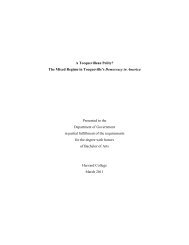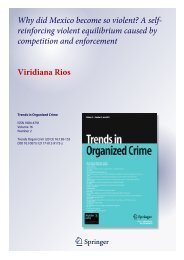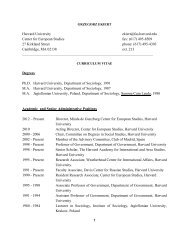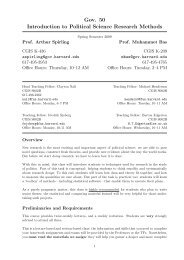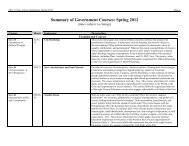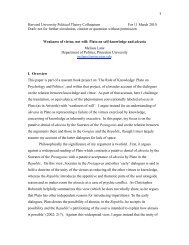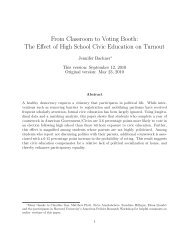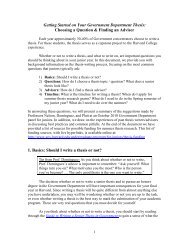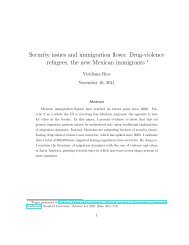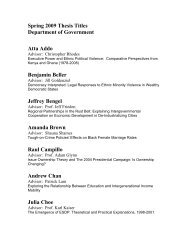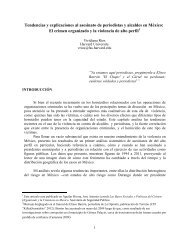Supreme Court Agenda Setting in a System of Shared Powers Ryan ...
Supreme Court Agenda Setting in a System of Shared Powers Ryan ...
Supreme Court Agenda Setting in a System of Shared Powers Ryan ...
You also want an ePaper? Increase the reach of your titles
YUMPU automatically turns print PDFs into web optimized ePapers that Google loves.
2 The Journal <strong>of</strong> Law, Economics, & Organization. V0 N0<br />
countability” and, therefore, “an affront to the system <strong>of</strong> checks and balances”<br />
(Calabresi and L<strong>in</strong>dgren, 2006a, 813)?<br />
Numerous studies exam<strong>in</strong>e whether justices rule differently when they anticipate<br />
legislative resistance to their decisions (Segal, 1997; Hansford and<br />
Damore, 2000; Sala and Spriggs, 2004) but they are limited <strong>in</strong> important ways<br />
that prevent us from understand<strong>in</strong>g whether the <strong>Court</strong> truly is as <strong>in</strong>dependent<br />
as Calabresi and L<strong>in</strong>dgren (2006a,b) fear, or, whether it is a strategic separation<br />
<strong>of</strong> powers (SOP) actor that decides cases <strong>in</strong> l<strong>in</strong>e with majoritarian preferences.<br />
More specifically, these studies are limited by their exclusive focus<br />
on the <strong>Supreme</strong> <strong>Court</strong>’s merits decisions (but see Owens, 2008). Because the<br />
<strong>Supreme</strong> <strong>Court</strong> sets its own agenda—and does so <strong>in</strong> private—it might decl<strong>in</strong>e<br />
to review cases likely to engender hostility from the political branches. That<br />
is, the <strong>Court</strong> can avoid trouble simply by decl<strong>in</strong><strong>in</strong>g to decide a case. What may<br />
look at the merits stage like a <strong>Court</strong> act<strong>in</strong>g without regard to legislative and executive<br />
preferences may, <strong>in</strong> fact, be a <strong>Court</strong> that has already filtered out cases<br />
strategically. What is needed, then, is an exam<strong>in</strong>ation <strong>of</strong> whether the separation<br />
<strong>of</strong> powers <strong>in</strong>fluences the <strong>Court</strong>’s agenda decisions.<br />
In this paper, I exam<strong>in</strong>e whether the <strong>Court</strong> strategically sets its agenda <strong>in</strong> a<br />
separation <strong>of</strong> powers context. I analyze 430 petitions for review and appeals<br />
filed with the <strong>Court</strong> between its 1953 and 1993 terms. I test the empirical implications<br />
<strong>of</strong> various theoretical SOP models.<br />
My results could not be clearer. Across every model I test, the <strong>Court</strong> failed<br />
to follow the separation <strong>of</strong> powers prediction. Simply put, the <strong>Court</strong> sets its<br />
agenda without regard to congressional and legislative preferences. Given that<br />
the agenda sett<strong>in</strong>g process is the stage <strong>in</strong> which the <strong>Court</strong> is most likely to<br />
show signs <strong>of</strong> strategic SOP behavior, these results cast serious doubt on strategic<br />
SOP theories. The results further speak to normative questions regard<strong>in</strong>g<br />
the <strong>Court</strong>’s role <strong>in</strong> contemporary government. S<strong>in</strong>ce “a central problem <strong>of</strong> representative<br />
democracy is how to ensure that policy decisions are responsive<br />
to the <strong>in</strong>terests or preferences <strong>of</strong> citizens,” (McCubb<strong>in</strong>s, Noll and We<strong>in</strong>gast,<br />
1987, 243) such a counter-majoritarian force must be reconciled with evolv<strong>in</strong>g<br />
concepts <strong>of</strong> democratic rule.<br />
The paper proceeds as follows: Section 2 describes the <strong>Court</strong>’s agendasett<strong>in</strong>g<br />
process. Section 3 then theorizes how a forward-th<strong>in</strong>k<strong>in</strong>g <strong>Supreme</strong><br />
<strong>Court</strong> might set its agenda <strong>in</strong> an SOP context. Section 4 models the conditions<br />
under which the <strong>Court</strong> might grant or deny cases <strong>in</strong> such a context. Section 5<br />
expla<strong>in</strong>s the data and methods I use to test the strategic SOP theory. Section 6<br />
presents my results and section 7 concludes.<br />
2. The <strong>Agenda</strong>-<strong>Sett<strong>in</strong>g</strong> Process<br />
When a party <strong>in</strong> a lower court loses her dispute and wants the <strong>Supreme</strong><br />
<strong>Court</strong> to review her case, she files a petition for a writ <strong>of</strong> certiorari (“cert”) or an<br />
appeal with the United States <strong>Supreme</strong> <strong>Court</strong> Clerk. After check<strong>in</strong>g the petition<br />
or appeal to ensure it meets m<strong>in</strong>imum fil<strong>in</strong>g requirements, the Clerk sends<br />
the document to each <strong>of</strong> the justices’ chambers. The petition is then randomly



